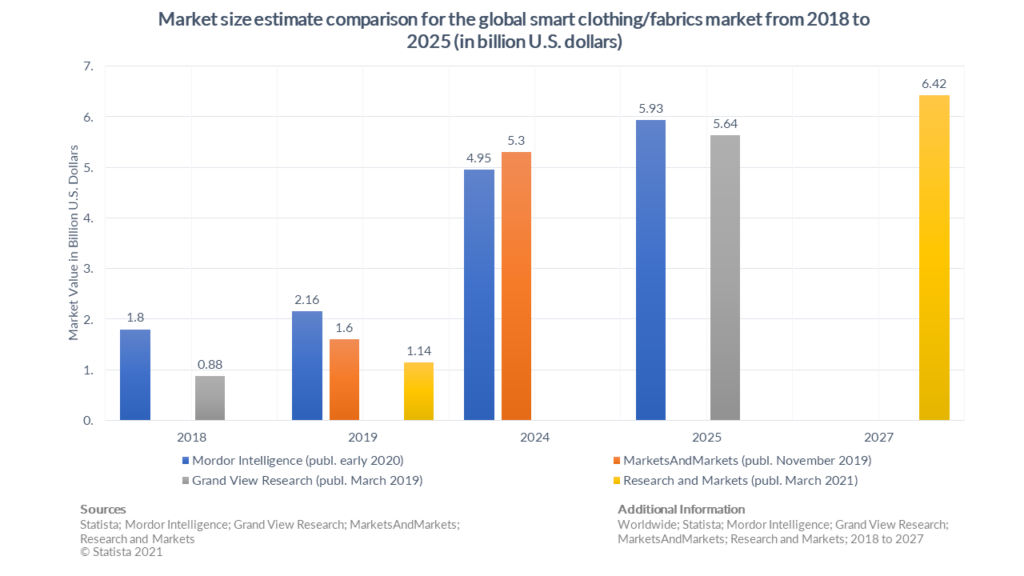The smart clothing market is experiencing significant growth globally. According to recent research, the market size was valued at USD 1.8 billion in 2019-18 and is projected to reach USD 6.42 billion by 2025, growing at a CAGR of 25.2% from 2020 to 2025. The increasing demand for fitness tracking and monitoring devices has been a driving force behind the growth of this market. However, the growth is based on a relatively low level and many are skeptical that are mainstream breakthrough is coming soon.
The global smart clothing items market size from 2018 to 2025 is expected to grow substantially due to technological advancements in textiles and electronics that have led to the development of e-textiles or smart fabrics. These fabrics can monitor physiological parameters like heart and respiration rates, making them particularly useful for athletes and patients.
The smart clothing item market is growing due to the captivating style and attractive qualities that consumers consider. Fitness enthusiasts usually prefer clothing that is easy to wash, sweat-resistant, and based on sensors. Smart clothes are embedded with small sensors that make it challenging for them to wash.
Companies are interested in sporting activities, which has led to a surge in interest in smart clothing. The global smart clothing market report comprehensively analyzes key segments, trends, drivers, restraints, competitive landscape, and key contributors in the market.

The Definition of the Global Smart Clothing Market
Smart clothes are clothing items created with technology with sensors and different electronics based on consumer requirements. They are integrated into clothes to offer smart technology in clothes, smart socks, smart footwear, smart devices for work, and smart sleepwear to improve sleep quality. In the military, it is used to make bulletproof clothing for soldiers, enhancing their safety. However, also innovative fabrics can be counted as smart clothes. Smart clothing can make people’s lives more comfortable. Clothing utilizing sensor technologies protects from serious injuries. The famous applications include defense, military, and health, and applying technology in fitness.
Overview of the Global Smart Clothing Market
The market for smart clothing is experiencing a swift increase because of the need for newer kinds of clothes with sensors that allow people to monitor the state of their bodies on their own. The government is also investing in creating new equipment for soldiers that can provide resistance against explosions.
Smart clothing can also track body metrics, for instance, heart rate, and respiration rate, which may assist an athlete in methodically planning their exercise and protect against injuries, which may result in higher performance in sports. This has an important impact on the growth of the global economy.
Smart clothing aims to make life easier and improve your health by giving you more insights and addressing the earlier stages of developing health issues. Awareness among people can fuel the smart clothing market’s growth.
One of the leading factors in preventing injuries in sports today is smart clothing, which can stop the number of injuries in play. However, also older people can benefit from innovations here by compression clothes and similar medical applications.
Smart clothing market growth is also due to the data gathered about a person’s sleep patterns, for example, how many times they wake up at night and the duration of their sleep. Such data is useful to people who experience insomnia.
A sharp rise in the cost of wearable technology is a limiting factor to the growth of the smart clothing market, as this contributes to the high prices of these gadgets.
Segmentation of the Global Smart Clothing Market
The global smart clothing market is segmented into Textile Types, Products, End-Users, and Geography.
Products
The industry of global markets is segmented into innerwear, upper wear, and lower wear according to their product. The sports and end-user industry is expected to grow at the fastest pace in the smart clothing market; the sensors in innerwear are used to monitor heart rate and breathing rate.
The Smart clothing market is developing the highest demand for running clothes because of the sensors present in these clothes that record time, distance, heart rates, and oxygen concentrations in blood. These threads can record calories burned, fatigue level, and sleep quality and suggest clothes appropriate for smart garment market.
- Innerwear
- Lower wear
- Upper wear
- Others
Textile Types
The market is divided into Ultra Smart, Passive Smart, and Active Smart based on textile type. Active smart textile has the largest market share in Smart Clothing Industry since active-smart textile comprises the property of sensing and reacting to signals.
- Ultra smart
- Active smart
- Passive smart
Product From User End
The global market is segmented into Apparel and Entertainment, Healthcare, Defense, Sports, Fitness, and Others based on the end user. Increased fitness awareness has contributed to growth in the smart clothing market in the fitness industry.
- Fashion and entertainment
- Sports and Fitness
- Healthcare
- Military and Defense
Geography Segmentation
Based on geographical analysis, the global market is broken down into North American, Asia-Pacific, European, Latin American, and Middle Eastern regions. North America is predicted to become the largest shareholder market in the forecasted period due to growing awareness of fitness in North America and economic strength; the demand in this area is growing for wearable clothes designed for monitoring health.
- North America
- Europe
- Middle-East and Africa
- Asia Pacific
- Latin America
Wrapping Up
I hope you enjoy this blog and quickly learn about the global smart clothes market size from 2018 to 2025. We will also discuss the market in various segments.




